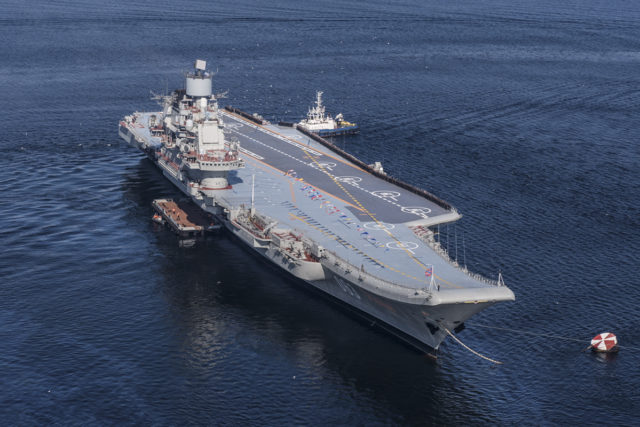
Russia’s armed forces have the ability to operate almost as an amorphous mass. Formations involving hundreds of thousands of troops can be mobilized, transferred or deployed; tens of thousands of items of equipment and numerous warplanes can move in a matter of days, from one end of the Eurasian continent to the other. The West possesses no comparable capability.
The same applies but in a different way to naval forces. Vessels are transferred or deployed between fleets temporarily or permanently as operations demand. Rather than sea routes, smaller warships can, when needed, be transported along Russia’s extensive system of navigable rivers and inland waterways linking the White Sea, the Volga, and Caspian and Black Seas.
Fleets and Headquarters
Russian vessels are generally intended to engage primarily in support of land operations in coastal waters and enclosed seas. High seas areas where they would conduct ship-to-ship operations are mainly the North Atlantic and to a lesser extent the Pacific. In effect, most of the Black Sea for example, is covered by long range, shore-based, ultra-high-speed anti-ship missiles, some of which are nuclear capable, stationed mostly in Crimea.
Russia’s four fleets consist of:
The Northern Fleet based at Severomorsk on the Arctic Kola Peninsula only 150 miles from the Norwegian border. It houses Russia’s nuclear ballistic submarine (SSBN) fleet and comprises the Northern Fleet Joint Strategic Command, formed in 2014, now responsible for the entire Arctic Sea and coastline through to Alaska;
The Baltic Fleet, headquartered in Russia’s strategic Kaliningrad enclave between Poland and Lithuania. It includes the Leningrad Naval Base (sic) at St. Petersburg, and its nearby Kron-shtadt base. Kaliningrad has been upgraded significantly in the last five years with extra berthing and vessels and more personnel and naval aviation;
The Black Sea Fleet, headquartered in Sevastopol in the Crimea, was under long-term lease from Ukraine until the territory was annexed by Russia in 2014. It also commands operations in the Mediterranean Sea and the Caspian Flotilla. This consists of smaller coastal vessels and had a crucial role in firing cruise missiles against Islamist targets in 2015 in the Syria conflict; and
The Pacific Fleet based in Vladivostok. This, the last to be upgraded and modernized, is focused on the Sea of Okhotsk, Sea of Japan, South China and Philippine Sea and the Northern Pacific toward the Bering Strait.
Preparing of the Battle Space
All Russian confrontation projects are accompanied, in addition to or instead of conventional forces, by an array of less lethal measures, not only as a means of preparatory conditioning and degrading enemy capabilities but as instruments of conflict, acting as “force multipliers.” They can in themselves assist in making opposing sides more compliant, and avoid or minimize the need for “kinetic” war.
The most profound “conditioner” or “decision maker” in both Georgia and Ukraine has been the close proximity of overwhelming numbers of Russian conventional forces and behind that, unspoken, Moscow’s vast numerical superiority in tactical nuclear weapons and wide range of delivery means including surface and sub-surface naval vessels.
Lower-key but equally powerful measures include long-term agitation and propaganda, personalized social media and e-mail spoofing, jamming and spoofing GPS signals, active cyber attacks and EW (electronic warfare) jamming, and potential directed energy and non-nuclear electromagnetic pulse (EMP) effects.
Long-term preparative propaganda, disinformation, and distortion are a well-known effective tool. Bogus personal social media messages and accusations have been used against NATO forces in Ukraine and elsewhere. The effects on ships’ companies’ and shore staff effectiveness and morale, especially once at sea, of automatically “spoofed” personal family messages including even “pet names,” should not be discounted.
State-level cyber attacks, suspected of being perpetrated by Russia, were launched against Estonia and Georgia as far back as 2007 and 2008. These affect everyday life: blocking bank transactions, in-store purchases and the functioning of many service providers.
GPS spoofing and other location distortion have been used extensively in the Black Sea and northern Norway in recent years, leaving pilots and ships’ captains believing they are miles away from where they actually are. Thankfully there have been no serious accidents. Once the deception has been identified alternative, improvised navigation means have been used, sometimes very skillfully.
A further element of deception and distortion is the ability to create large numbers of electronic “ghost images,” or targets, including large numbers of aircraft, missiles or surface craft. This obviously creates confusion in decision making and interpretation, induces complacency and hesitation, and probes, exposes and exhausts readiness states and reaction times.
The overall intention is to establish “Reflexive Control” in which a potential enemy responds and over-reacts directly to hostile stimuli, degrades its own decision-making abilities and loses the initiative. Senior NATO and other experts believe this happened to a significant degree in the build-up to the 2008 Georgian War.
Generating Warfare
Military confrontations cannot be launched from a standing start. One needs a pretext. Consequently, Russia has grievances of one sort or another with most of its neighbors. It also has disputes in most of the sea areas where it has strategic or economic aims or interests. The most notable of these is the disputed undersea Lomonosov Ridge which extends beneath the Pole, from the New Siberian Islands and the Laptev Sea to Canada’s Ellesmere Island, which Russia claims as an extension of its continental shelf.
Russia’s perspective is that through a doctrine of low risk, low gain, one can over time achieve most of one’s objectives incrementally or by adeptly exploiting opportunities.
If Russian intentions are blocked in one direction they will be increased in other directions. If the Kremlin’s aims are thwarted in one land or sea area, beware of key point vulnerabilities elsewhere. Russian air and naval intrusions and maritime near misses are at so high a rate that the only way to increase their significance is to make them more dangerous or intrude deeper into Western operating spaces, or to deploy more aggressive and larger numbers of powerful assets including missiles toward the West and appropriate maritime assets in relevant sea areas. This is arguably beginning to be achieved by mammoth naval fire power demonstrations.
A further scenario is “Unavoidable War” in an episode similar the Kerch Strait incident in November 2018 in which with shots fired and ramming, Russian forces seized three Ukrainian Navy vessels and 24 crew, three of whom were wounded while attempting to enter the Sea of Azov under the Russian Kerch Bridge connecting Crimea with southern Russia. The concern is that always encouraged and supported by the Kremlin and the Russian public, naval or air forces including maritime aviation, through over-enthusiasm, could overstep the mark resulting in significant damage, casualties or loss of life. This would leave Western governments in a position in which harsh, escalating, but unavoidable action would have to be taken.
Cutting Edge Capabilities
Whatever dark programs the West may possess, Russia has several field leaders of its own.
Poseidon (NATO Kanyon), previously known by its code name “Status-6 oceanic multi-purpose system,” is a long range, nuclear-powered and nuclear-capable unmanned, torpedo-shaped, robotic mini-submarine. It reputedly can travel at up to 50 knots (60 mph), with a maximum range of 6,000 miles at a depth of 3,000 ft. Capable of striking the U.S. eastern seaboard or a U.S. carrier group, as a weapon of last resort, its claimed role is to contaminate wide coastal or ocean areas with toxic radioactive Cobalt-60. Diagrams of the weapon were revealed deliberately during a Kremlin defense briefing in 2015.
An area in which Moscow can be said to have cutting edge capabilities is clandestine deep-water operations. Russia possesses a range of submarines and submersible craft from mini-subs to very large submarine mother ships, most of which are nuclear powered. Some are reputedly capable of diving as deep as 10,000 or even 20,000 feet. The crews are honored as “hydronauts.”
Their operational roles are sub-surface intelligence gathering, including high-volume eavesdropping of Internet traffic on fiber-optic cables across the Atlantic, placing vessel sensors at strategic sites on the ocean floor, clandestine mine laying and sabotage including severing intercontinental communications’ cables, pipelines and oil rig components.
They are the responsibility of two very shadowy organizations; the Ministry of Defense’s Deep-Water Research Main Directorate (GUGI) and what is known only as military unit No. 40056. They are affiliated with GRU military intelligence and assigned to the 29th Independent Submarine Brigade, of the Northern Fleet, based at Gadzhiyevo on the Kola Peninsula.
Targets and Areas of Interest
To make its presence felt, in summer 2019, the Russia Navy conducted mammoth live fire exercises, with exclusion zones, each involving as many as 30 vessels in Baltic, Black, Norwegian, and Barents Sea areas.
The naval term “Anti-Access/Area-Denial” (A2/AD) was viewed until recently as unfashionable. It means preventing an adversary from occupying or transiting an air, land, or sea area.
It is believed that in a crisis or conflict, Kremlin objectives would be to establish large “A2/AD umbrellas” around the Arctic Kola Peninsula, the Baltic Sea, and much of Scandinavia and the United Kingdom, enabling it to conduct selective expeditionary, force projection operations as it did in Syria in April 2018.
Pacific
In the Far East and Pacific Ocean, Moscow’s maritime interest is focused on the northern Pacific and Sea of Japan. It is expanding its defense, naval tracking and early warning infrastructure on the Kuril Islands stretching from the Kamchatka Peninsula to Japanese-claimed Hokkaido.
Moscow has recently created the embryonic Chukotka “Operational Direction.” This refers to the large eponymous mineral rich territory facing Alaska across the narrow Bering Strait.
In the northern Pacific one of Russia’s key concerns is industrial scale illegal fishing. Somewhat incongruously, to counter this, Moscow works in cooperation with the U.S. Coast Guard 17th District headquartered in Juneau, Alaska.
Arctic and Energy resources
The Northern Fleet and its “combined-arms” Joint Strategic Command, along with the Federal Security Service (FSB), is responsible for the defense and security of the Arctic Sea, its coast, and scattered island groups including Franz Josef Land, on which at 80°N latitude, it has recently inaugurated the world’s most northerly airbase at Nagurskoye. Other islands are becoming increasingly militarized with jetties, air fields, and electronic surveillance.
A principal Northern Fleet responsibility is the enforcement of the so-called “Northern Sea Route,” commercially connecting the Bering Strait and North Atlantic and providing a cost and time saving shortcut. The project is assisted by melting polar ice fields. The Kremlin claims authority over the NSR in the same way as Panama and Egypt control the Panama and Suez canals, respectively, and intends to charge for passage. The rest of the world however, views the route as the high seas, open to free navigation.
There are, though, more important considerations. Russia and China intend to pool and exploit their cross-border efforts in extracting and refining liquid petroleum gas (LPG) and other fossil fuels and export them through ports on the Arctic Sea, the Chukotka peninsula and China itself.
One should not forget that the permanent gas troika of Russia, Qatar, and Iran already controls more than 50 percent of the world’s supplies including through ownership of fields in other territories. Some highly respected government observers believe the long-term aim may be to quote and trade LPG on world markets in Chinese yuan (¥) and not U.S. dollars ($).
Greenland-Iceland-UK (GIUK) Gap
Few are currently familiar with the defense term “GIUK Gap.” It denotes the ocean space, the dominance of which controls all crossings of the North Atlantic.
The general assumption until very recently of NATO navies has been that possession of the North Atlantic is a given and it is their own sea or “mare nostrum.” In the last decade and a half, however Russian naval hull numbers have radically increased while Western hull numbers have declined. Russian vessels are operating around and below the gap. The Russian navy also regularly carries out large scale exercises in the Norwegian Sea and parts of the North Sea.
In short it means that in time of tension or conflict reinforcement and resupply of Europe, including NATO’s “enhanced Forward Presence” (eFP) in the Baltic states, cannot be achieved without cost.
Baltic Sea
The Baltic Fleet’s objectives in time of confrontation would be to leverage naval parity or superiority in order to freeze naval movements; and if hostilities developed to achieve local area supremacy or A2/AD in order to enable the interdiction of NATO’s navies and to conduct amphibious landings.
The target areas for landings would be key points as deep as possible towards the west of the Baltic, in order to cause maximum disruption, dislocation and diversion. In addition, any successful landing in force on one of the mid-Baltic islands of Bornholm (Denmark), Gotland (Sweden) or the Åland island group (Finnish), would realize almost regional domination.
Black, Mediterranean, and the Caspian Seas
The situation in the Black Sea is comparatively calm with no immediate disputes or objectives against regional neighbors, although there is obvious hostility towards Georgia. Naval operations and Russia’s permanent flotilla in the Mediterranean are commanded from the Black Sea Fleet’s headquarters in Sevastopol in (annexed) Crimea.
Russia’s only permanent overseas naval base and logistics center, currently being upgraded, is Tartus, Syria, which is on long-term lease. In the future it may be possible to station Russian warships there continuously.
Persian Gulf
Russia has vowed to establish a presence in the Persian Gulf in view of the current stand-offs and crises.
Speculation continues in the Russian press that the Russian Navy will be offered long-term bases in Iran at Bandar Bushehr in the central Gulf and, or at Chekhbekhar on the north shore of the Gulf of Oman, a little less than 100 miles from the Pakistan border.
Sources relate fancifully that they would be guarded by Russian special forces and that warships based there could be include nuclear submarines, and that Russia is envisaging the air base at Bandar Bushehr as a hub for its latest Su-57 fighters; but who is to say?
A secret memorandum of understanding (MoU) was signed between Rear Admiral Hossein Khanzadi, commander of the Iranian Navy, and Russian Navy chief Admiral Nikolai Anatolevich Evmenov on July 29 in St. Petersburg. The two countries are shortly to hold joint exercises in the Indian Ocean, the Strait of Hormuz and the Gulf and later in the Caspian Sea.
Conclusion
It is impossible to create apposite NATO hull numbers or to train and establish suitable numbers of experienced crews in less than five to 10 years. The situation comes concurrently with other massive budget demands including competing defense projects. The only interim solution might be more rapidly and less expensively developing and introducing as a priority world beating hi-tech naval systems.
In the meantime, when it comes to Russian naval challenges, one might bear in mind that an optimist is merely an ill-informed pessimist.
Bruce Jones is a security policy adviser who has lived and worked in Russia and the former Soviet Union. He writes for Jane’s Defence publications and newspapers including the Sunday Times (UK).





